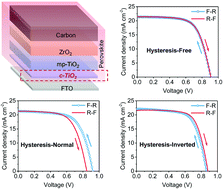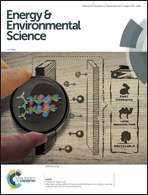Tunable hysteresis effect for perovskite solar cells†
Abstract
Perovskite solar cells (PSCs) usually suffer from a hysteresis effect in current–voltage measurements, which leads to an inaccurate estimation of the device efficiency. Although ion migration, charge trapping/detrapping, and accumulation have been proposed as a basis for the hysteresis, the origin of the hysteresis has not been apparently unraveled. Herein we reported a tunable hysteresis effect based uniquely on open-circuit voltage variations in printable mesoscopic PSCs with a simplified triple-layer TiO2/ZrO2/carbon architecture. The electrons are collected by the compact TiO2/mesoporous TiO2 (c-TiO2/mp-TiO2) bilayer, and the holes are collected by the carbon layer. By adjusting the spray deposition cycles for the c-TiO2 layer and UV-ozone treatment, we achieved hysteresis-normal, hysteresis-free, and hysteresis-inverted PSCs. Such unique trends of tunable hysteresis are analyzed by considering the polarization of the TiO2/perovskite interface, which can accumulate positive charges reversibly. Successfully tuning of the hysteresis effect clarifies the critical importance of the c-TiO2/perovskite interface in controlling the hysteretic trends observed, providing important insights towards the understanding of this rapidly developing photovoltaic technology.



 Please wait while we load your content...
Please wait while we load your content...